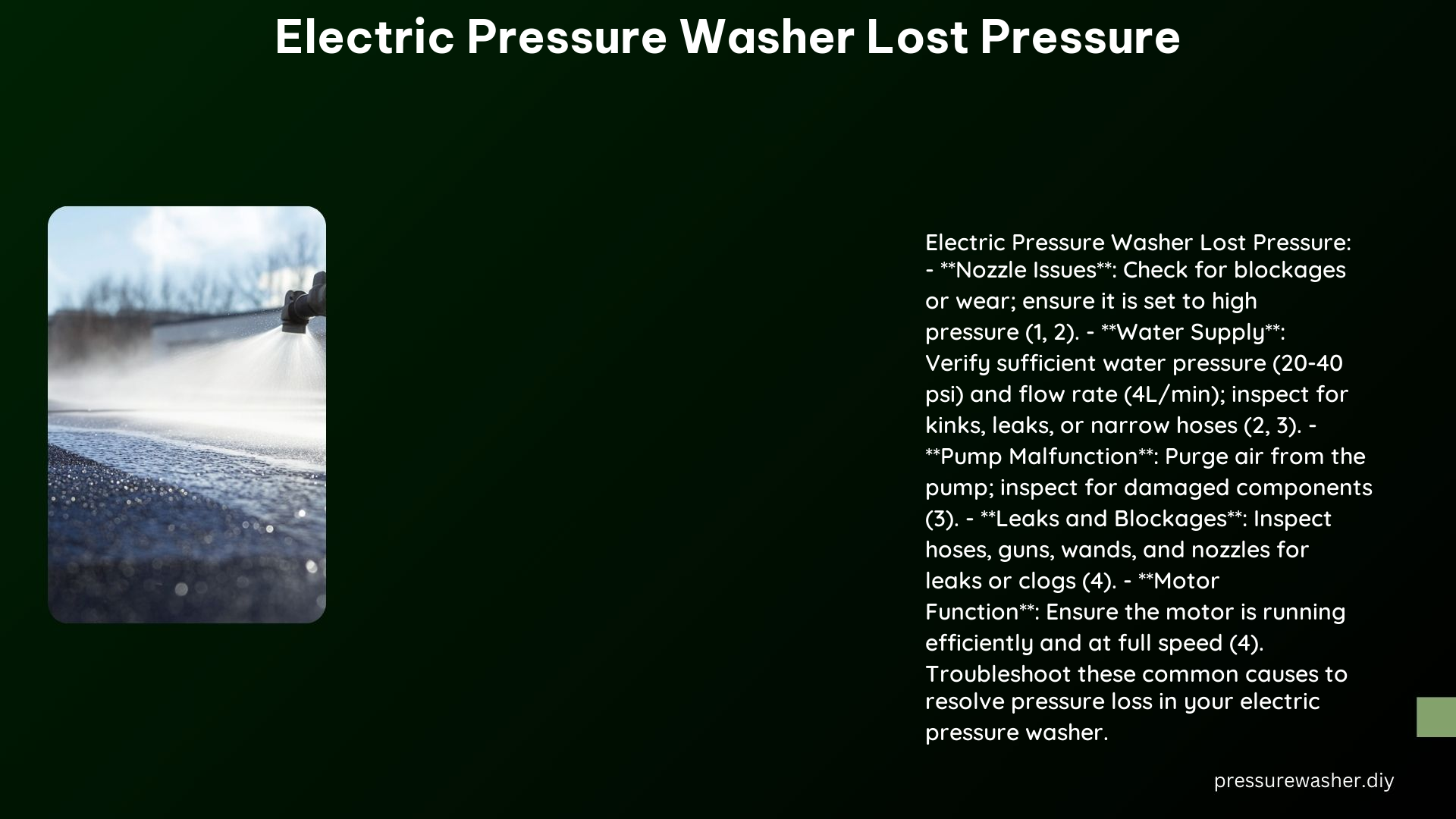If your electric pressure washer has suddenly lost pressure, it can be frustrating and disrupt your cleaning tasks. However, most of the time, the issue can be easily resolved by identifying and addressing the root cause. Here is a comprehensive guide to help you troubleshoot and repair the problem of pressure loss in your electric pressure washer.
Common Causes of Pressure Loss
1. Blocked or Worn Nozzle
- A blocked nozzle can prevent water from escaping, causing a drop in pressure.
- A worn nozzle can allow too much water to pass through, also leading to pressure loss.
- Nozzle orifice size typically ranges from 0.15 to 0.50 inches (3.8 to 12.7 mm) in diameter, depending on the model.
- Nozzle flow rate can vary from 0.5 to 2.0 gallons per minute (GPM) or 1.9 to 7.6 liters per minute (LPM).
2. Holes and Leaks
- Inspect the high-pressure hose and all connections for any holes or leaks that could be reducing pressure.
- Hose diameter is usually 1/4 to 3/8 inches (6.4 to 9.5 mm) and can withstand pressures up to 3,000 psi (207 bar).
- Replace any damaged or worn-out hoses or fittings to ensure a tight, leak-free system.
3. Low-Pressure Water Supply
- Ensure the water supply is sufficient, as low pressure can prevent the washer from functioning properly.
- Minimum water supply pressure should be at least 20 psi (1.4 bar) for most electric pressure washers.
- Check the water inlet and filter screen for blockages or damage and clean or replace them if necessary.
4. Wrong Size Hose
- Verify that the hose is the correct size for your pressure washer model.
- Using a hose with a smaller diameter than recommended can restrict water flow and reduce pressure.
- Consult the manufacturer’s specifications for the recommended hose size, which is typically 1/4 to 3/8 inches (6.4 to 9.5 mm) in diameter.
5. Unloader Valve Issues
- The unloader valve regulates pressure and prevents overheating by diverting water back to the inlet when the trigger is released.
- Check the unloader valve for proper function and clean or replace it if necessary.
- Unloader valves are typically rated for pressures up to 3,000 psi (207 bar).
6. Pressure Regulator Issues
- The pressure regulator ensures consistent pressure by adjusting the water flow.
- Inspect the regulator for any blockages or malfunctions and replace it if necessary.
- Pressure regulators are often rated for pressures up to 4,000 psi (276 bar).
Troubleshooting Steps

- Disconnect Power and Water Supply:
-
Before starting any repairs, disconnect the pressure washer from the power source and turn off the water supply.
-
Check Nozzles and Hoses:
- Inspect the nozzle and high-pressure hose for blockages, damage, or wear.
- Clean the nozzle orifice using a thin wire or replace the nozzle if necessary.
-
Replace any damaged or worn-out hoses.
-
Verify Water Supply:
- Ensure the water supply is sufficient and not restricted.
- Check the water inlet and filter screen for blockages or damage, and clean or replace them if necessary.
-
Verify the water supply pressure is at least 20 psi (1.4 bar).
-
Inspect Unloader Valve and Pressure Regulator:
- Check the unloader valve and pressure regulator for proper function.
- Clean any debris or deposits from the valves and ensure they are operating smoothly.
- Replace the unloader valve or pressure regulator if they are malfunctioning.
Technical Specifications
- Pressure Range: Electric pressure washers typically provide between 1,300 and 1,700 pounds per square inch (psi) or 90 to 117 bar of pressure, although some models can reach up to 3,000 psi (207 bar).
- Water Flow Rate: Most electric pressure washers require a minimum flow rate of 4 liters per minute (LPM) or 1.1 gallons per minute (GPM) to function properly.
- Pump Maintenance: Regularly check and maintain the pump by purging air and adding oil as recommended by the manufacturer. Pump oil capacity is usually between 4 and 8 ounces (118 to 236 ml).
References
- Husqvarna NZ. (n.d.). Why Has My Pressure Washer Lost Pressure? | Pressure Washer Repair Guide. Retrieved from https://www.husqvarna.com/nz/learn-and-discover/why-has-my-pressure-washer-lost-pressure-pressure-washer-repair-guide/
- JustAnswer. (2011, September 8). Why does the pressure washer suddenly lose pressure, then regain it? Retrieved from https://www.justanswer.com/small-engine/5ivdz-does-pressure-washer-suddenly-lose-pressure-regain.html
- Repair Clinic. (2022, July 15). No Water Pressure In Your Pressure Washer? 2 Likely Causes. Retrieved from https://diy.repairclinic.com/no-water-pressure-in-your-pressure-washer-2-likely-causes/
- YouTube. (2019, June 11). Fix a PRESSURE WASHER with NO PRESSURE in 60 SECONDS. Retrieved from https://www.youtube.com/watch?v=pREA26rFcLc
- Briggs & Stratton. (n.d.). Why is my pressure washer producing low or no pressure? Retrieved from https://www.briggsandstratton.com/na/en_us/support/faqs/browse/pressure-washer-produces-low-pressure.html
